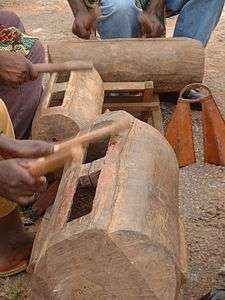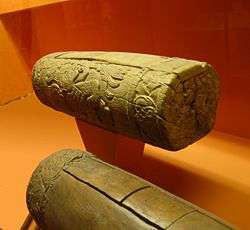Slit drum
A slit drum is a hollow percussion instrument. In spite of the name, it is not a true drum but an idiophone, usually carved or constructed from bamboo or wood into a box with one or more slits in the top. Most slit drums have one slit, though two and three slits (cut into the shape of an "H") occur. If the resultant tongues are different width or thicknesses, the drum will produce two different pitches. It is used throughout Africa, Southeast Asia, and Oceania. In Africa such drums, strategically situated for optimal acoustic transmission (e.g., along a river or valley), have been used for long-distance communication.[1]

The ends of a slit drum are closed so that the shell becomes the resonating chamber for the sound vibrations created when the tongues are struck, usually with a mallet. The resonating chamber increases the volume of the sound produced by the tongue and presents the sound through an open port. If the resonating chamber is the correct size for the pitch being produced by the tongue, which means it has the correct volume of airspace to complete one full sound wave for that particular pitch, the instrument will be more efficient and louder.
The people of Vanuatu cut a large log with "totem" type carvings on the outer surface and hollow out the center leaving only a slit down the front. This hollowed out log gives the deep resonance of drums when hit on the outside with sticks.
.jpg)
List of slit drums
- Agung a Tamlang (Philippine) – Maguindanaon
- Alimba – Zairean
- Ekwe – Igbo
- Ikoro – Igbo
- Gato – 20th century American, originally a brand name, later generic[2]
- Huiringua – Mexico
- Kagul (Philippine) – Maguindanaon
- Kentongan – Java, Indonesia
- Krin (log drum) or Kolokolos – Guinea
- Kulkul – Bali, Indonesia
- Lali – Fiji
- Lokole – Congo Basin
- Mayohuacán – Taino people (Puerto Rico, Cuba, Dominican Republic, Caribbean)
- Mondo – West Africa
- Mukoku – Yaka people (Congo)
- Pate – Samoa, Cook Islands, and other parts of Polynesia
- Tagutok (Philippine) – Maranao
- Teponaztli – Mesoamerican
- To'ere – Tahiti
- Tongue drum
- Vanuatu slit drum
- Garamut – Papua New Guinea
Gallery
 Two Aztec slit drums, called teponaztli. The characteristic "H" slits can be seen on the top of the drum in the foreground.
Two Aztec slit drums, called teponaztli. The characteristic "H" slits can be seen on the top of the drum in the foreground.- Wooden slit drums from Vanuatu, Bernice P. Bishop Museum
 Ekwe drum of the Igbo people
Ekwe drum of the Igbo people Banda-Yangere animal-shaped slit drum
Banda-Yangere animal-shaped slit drum
See also
Notes
- Hart, Mickey; p. 52
- Gato drum, Metropolitan Museum of Art, New York
References
- Hart, Mickey, and Fredric Lieberman, with D. A. Sonneborn (1991). Planet Drum: A Celebration of Percussion and Rhythm. New York: HarperCollins. ISBN 9780062504142, ISBN 9780062503978, ISBN 9780062504623. OCLC 23357061.
External links
| Wikimedia Commons has media related to Slit drums. |
- Collins Rhythmcraft page on slit drums
- Drum Museum Siebenborn, Infos about antique slit drums and hand drums from Africa and New Guinea
- Beauty of Life Blog – A few examples of wooden slit gongs from Asia, including elephant bells.